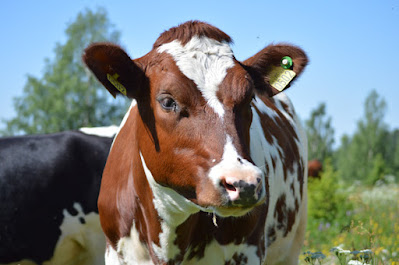Genetics are an efficient tool to achieve healthier cows and thereby contribute to empty the sick pen. Breeding gives a permanent and cumulative effect; genetic improvement achieved today is of value also for future generations.
Good genes for health may become even more valuable in the future as antibiotic resistance is a serious and growing problem globally, and we may have to change the way we use antibiotics also in livestock production.
 |
| Genetics role in antibiotic reduction |
More than 40 years of selection
Norwegian Red was the first breed worldwide to include direct selection for health traits in 1978. Since then, health been an important focus of the breeding goal, and the current total merit index includes clinical mastitis as part of the udder health index and “other diseases,” which is a composite trait group including the most common diseases other than mastitis (milk fever, ketosis and fertility-related disorders). Compared to other dairy breeds, Norwegian Red has put more emphasis on health traits over a longer time period. Genetic trends for Norwegian Red demonstrate that despite unfavorable genetic correlations between milk yield and mastitis, it is possible to obtain genetic improvement of both traits if estimated breeding values are reliable and traits receive an appropriate weight in the total merit index used for selection.
Reliable phenotypes is key
Direct selection for health traits requires recording of disease events. This is well-established in Norway, where each case of veterinary treatment has been registered on an individual cow basis since 1975. Figures for 2020 show that 97% of the dairy herds in Norway participate in the Norwegian Dairy Herd Recording System, where individual health recording is integrated. Veterinarians can report treatments directly to the central database. Because antibiotics and other drugs can be prescribed only by veterinarians in Norway, these health records are viewed as good quality. Reliable phenotypes are key for successful breeding. The Norwegian health recording system made selection for healthier cows possible in the 1970s and is still crucial in the era of genomic selection to predict genomic breeding values for health traits.
Norway uses less antibiotics in livestock production
A report from the European Medicines Agency on the sales of veterinary anti-microbial agents in 31 European countries shows that Norway has the lowest use of antibiotics per kilogram of livestock biomass among these countries. Livestock production in Sweden uses almost four times, Denmark 10 times, Germany 30 times and Italy 100 times more antibiotics per unit produced product than Norway. The favorable situation in Norway is a result of action taken by the Norwegian farmers’ organizations decades ago, which aimed to reduce the unnecessary use of antibiotics. In dairy production, the treatment strategies changed, the Norwegian Cattle Health Service was established, mastitis control programs, advisory and herd management tools were developed, and the weight put on health traits in the breeding program for Norwegian Red increased. Norwegian Red is the main dairy breed in Norway, accounting for around 90% of the dairy cows. This joint action worked and resulted in fewer treatments per cow.
Healthy cows
The total number of veterinary treatments per cow and year was reduced from 1.3 in 1990 to below 0.4 today. The main reason is fewer cases of mastitis among Norwegian cows. Mastitis has been included in the breeding objective of Norwegian Red since 1978, and significant genetic improvement has been achieved. The genetic trends for mastitis in Norwegian Red show genetic improvement after the relative weight on mastitis increased in 1990. Thus, a considerable part of the observed reduction in veterinary treatments per cow per year is due to genetic improvement. Today’s Norwegian Red cows are healthier and have better genes for disease resistance than the cows we had 30 years ago.
Breeding for better lives
Animal health is critical for animal welfare as well as farmer’s welfare, and it is important for economy and quality of production. Breeding healthier cows will also contribute to reduced use of antibiotics. This may be increasingly important as antibiotic resistance is a serious and growing problem globally. Good genes for animal health will therefore probably be even more valuable in the future.
